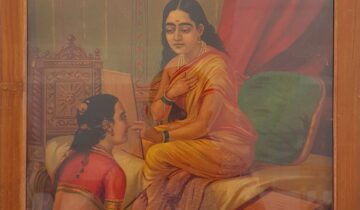From the Pages of History: 6 Fascinating Indian Historic Paintings
Introduction :
India, a land steeped in history and culture, has produced some of the world’s most captivating and influential art throughout the ages. From the intricate cave paintings of Ajanta to the resplendent Mughal miniatures and the enchanting Pichwai paintings, the canvas of Indian Historic Paintings is adorned with an array of mesmerizing artworks that not only reflect the artistic prowess of their creators but also offer profound insights into the country’s rich heritage.
In this journey through time, we invite you to embark on a visual odyssey as we delve deep into the annals of Indian artistry. Our destination: a selection of six historic paintings, including the enchanting Pichwai paintings, that have left an indelible mark on the cultural tapestry of India. These masterpieces are not just strokes of paint on canvas; they are windows into bygone eras, stories waiting to be told, and cultural treasures waiting to be unveiled.
As we navigate through the colors, techniques, and narratives woven into these historic paintings, including the vibrant Pichwai paintings, you will discover the diverse influences, the royal patronage, the spiritual expressions, and the artistic innovations that have shaped Indian art. Each stroke of the brush and every hue on the canvas carries with it a piece of India’s past, waiting for you to explore and appreciate.
Join us on this enthralling voyage through history as we unlock the secrets and stories behind these six fascinating Indian historic paintings, including the exquisite Pichwai paintings, showcasing the artistic genius that continues to inspire and resonate with art enthusiasts worldwide.
Unveiling Treasures: A Close Look at 6 Fascinating Indian Historic Paintings
1. Pichwai Paintings: The Divine Artistry
Our captivating journey commences in the sacred town of Nathdwara, nestled in the culturally rich state of Rajasthan, India. Here, the walls of temples and homes come alive with the exquisite beauty of Pichwai paintings. These art forms, steeped in tradition and spirituality, offer a mesmerizing portrayal of Lord Krishna’s divine essence, frequently set against the enchanting backdrop of the holy town of Vrindavan.
Pichwai paintings are renowned for their intricate craftsmanship and vibrant palette that seems to dance with life. With meticulous attention to detail and the lavish use of vibrant pigments, often accentuated by
the delicate touch of gold leaf embellishments, each Pichwai painting is a true masterpiece in its own right.
But these creations are more than just artistic expressions; they are profound labors of love. Behind every stroke of the brush lies the profound devotion of the artists, who pour their hearts and souls into every piece. Their commitment to preserving the stories and legends of Lord Krishna’s life is a testament to the enduring cultural and spiritual significance of Pichwai paintings, which continue to captivate the hearts of art enthusiasts and spiritual seekers alike.
2. Ajanta Cave Paintings: Timeless Elegance
Transporting ourselves to the depths of antiquity, specifically the 2nd century BCE, we find ourselves immersed in the captivating world of the Ajanta Cave paintings. Located in the heartland of Maharashtra, the Ajanta Caves are a treasure trove of exquisitely preserved frescoes and murals. These artworks serve as poignant windows into a bygone era, vividly portraying not only the life of the Buddha but also providing glimpses into the intricacies of ancient Indian society.
These remarkable paintings are a testament to the incredible skill and artistry of the individuals who crafted them. The artists’ meticulous attention to detail, combined with their profound understanding of aesthetics, has left an indelible mark on the annals of art history.
Furthermore, the use of natural pigments in these ancient masterpieces showcases the resourcefulness and ingenuity of the artisans, as these pigments have endured the test of time and are still resonating with contemporary art enthusiasts and historians alike.
Venturing deeper into the Ajanta Cave paintings, we uncover a tapestry of narratives that offer profound insights into ancient India’s art, culture, and societal norms. Each stroke of the brush and every pigment-laden hue narrates a story, shedding light on the religious, social, and artistic dynamics of a bygone era.
These paintings, much like the caves themselves, are a cultural treasure trove, inviting us to embark on a journey through time and immerse ourselves in the captivating world of ancient Indian artistry.
3. Mughal Miniatures: Portraits of a Dynasty
Journeying back in time to the illustrious Mughal era, we find ourselves immersed in the mesmerizing realm of Mughal miniatures. The Mughal Empire, renowned for its opulence, grandeur, and profound cultural contributions, has left an indelible mark on the landscape of Indian art. Within the ornate frames of Mughal miniatures, we encounter exquisite paintings that serve as windows to the past, offering captivating glimpses into the intricacies of the era.
These miniature marvels are not mere artworks; they are meticulously crafted capsules of history, portraying scenes from the resplendent royal court, capturing pivotal historical events, and offering intimate glimpses through intricate portraits of emperors. It is within the confines of these compact yet astoundingly detailed canvases that the fusion of Persian and Indian artistic styles flourished, giving birth to a unique and visually striking art form that continues to captivate art connoisseurs and enthusiasts alike.
As we delve deeper into the world of Mughal miniatures, we uncover the delicate brushwork, the vibrant color palettes, and the masterful storytelling that defines this extraordinary artistic tradition. Join us on a captivating journey through time as we explore the legacy of Mughal miniatures, a testament to the artistic brilliance that flourished during this golden era of Indian history.
4. Tanjore Paintings: Gilded Grandeur
In the picturesque southern state of Tamil Nadu, a remarkable form of artistry has graced the hearts of art aficionados for centuries – the exquisite Tanjore paintings. These opulent and richly detailed artworks constitute a veritable treasure trove of cultural and artistic heritage. Characterized by their resplendent use of vibrant colors, intricate embellishments, and the application of not just any gold but gold leaf and precious stones, Tanjore paintings represent a testament to India’s artistic brilliance.
These magnificent creations typically find their canvas adorned with depictions of deities, mythological scenes, or regal portraits, serving as vivid reflections of the region’s deep-rooted cultural and religious traditions. As you journey into the historical context of Tanjore paintings, you’ll uncover a tapestry woven with stories of devotion, craftsmanship, and the perpetuation of a unique artistic legacy.
However, the enchantment of Tanjore paintings reaches beyond historical confines. In present-day India, these artistic marvels retain a cherished status, serving not just as creative manifestations but as vibrant symbols of cultural identity. Their timeless relevance transcends epochs, uniting tradition with contemporary artistic sensibilities.
Join us on an enthralling journey as we delve into this exploration, unraveling the intricate threads of time to unveil the enduring allure and relevance of Tanjore paintings within the rich tapestry of Indian historic paintings.
5. Company School Paintings: A Fusion of Cultures
As we journey forward through time into the colonial era, we stumble upon a fascinating and distinctive genre of Indian historic paintings known as Company School paintings. This unique artistic movement took root during the rule of the British East India Company, signifying a captivating fusion of Indian and European artistic styles. These Company School paintings serve as a vivid testament to the cultural exchange that transpired during this period.
Company School paintings, with their intricate blend of influences, vividly portrayed Indian landscapes, the rich tapestry of flora and fauna, and scenes of everyday life. These artworks captured the essence of a changing India under colonial rule, where traditional Indian subjects met Western aesthetics. They often depicted the Indian way of life through the lens of European artistic techniques.
These paintings had multifaceted purposes, from documenting the botanical diversity of India to offering a glimpse into Indian culture for the British audience. They served as both art and documentation, reflecting the curiosity and exploration that characterized the era.
As we venture into the realm of Indian historic paintings, we will embark on a journey that not only examines the exquisite artistry of the Company School paintings but also unravels the rich historical tapestry that gave birth to these captivating creations. We will peer into the intricate techniques employed by the artists, allowing us to gain a profound appreciation for the interplay of cultures that defined this remarkable chapter in Indian art history.
6. Kalighat Paintings: Social Commentary in Art
As our captivating journey through the realm of Indian historic paintings nears its culmination, we find ourselves at the revered Kalighat Temple in Kolkata, where the vibrant and satirical Kalighat paintings had their genesis. These remarkable artworks, hailing from the 19th century, unveil a candid and often humorous commentary on the multifaceted facets of contemporary society, politics, and culture.
Steeped in bold, striking colors, these paintings employ simple yet highly expressive forms, combined with clever wit, to convey their incisive messages. In doing so, they manage to strike a delicate balance between entertainment and introspection, making Kalighat paintings both a source of amusement and food for thought.
Our exploration delves into the realm of Indian historic paintings, specifically focusing on the captivating world of Kalighat artworks. In this journey, we unearth the rich socio-cultural tapestry that served as the fertile soil for the creation of these masterpieces. We embark on a voyage through the intricate interplay of influences, ranging from local traditions to global interactions, that played a pivotal role in shaping these remarkable Indian historic paintings.
Furthermore, we shine a light on the transformative power of artistic expression, vividly exemplified by the Kalighat artists who skillfully wielded their brushes as instruments of commentary and critique, adding a profound layer of depth to the narrative of these captivating artworks.
So, let’s come together as we wrap up this enlightening expedition, immersing ourselves in the captivating realm of Indian Historic Paintings, where art acts as a mirror, faithfully reflecting the spirit of its era and location.
Conclusion
Indian historic paintings offer a remarkable journey through time and a unique lens through which to view the country’s rich history, culture, and artistic evolution. From the divine beauty of Pichwai paintings to the intricate details of Mughal miniatures, each of the six art forms discussed in this exploration holds a unique place in India’s artistic heritage. They serve as a reminder of the rich tapestry of India’s history and the enduring legacy of its artistic traditions.
These Indian Historic Paintings not only provide aesthetic pleasure but also offer valuable insights into the social, religious, and political aspects of their respective eras. They are a testament to the creativity and skill of Indian artists, who have continued to captivate audiences with their artistry for centuries.
As we explore these fascinating Indian historic paintings, we gain not only a deeper understanding of India’s past but also a profound appreciation for the enduring beauty and cultural significance of its artistic treasures. These artworks are not merely pages of history but living testaments to the artistic brilliance that has flourished in this ancient land for millennia.









 No products in the cart.
No products in the cart. 